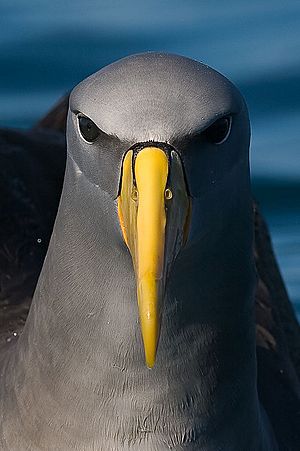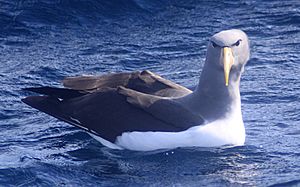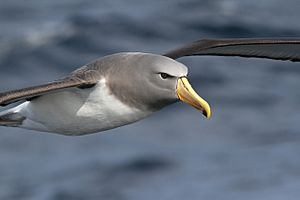Chatham albatross facts for kids
The Chatham albatross is a type of albatross. It's also called the Chatham mollymawk. This medium-sized bird is black and white. It only nests on a big rock called The Pyramid. This rock is part of the Chatham Islands in New Zealand. Some people think it's a smaller version of the shy albatross. It's the smallest bird in the shy albatross family.
Quick facts for kids Chatham albatross |
|
|---|---|
 |
|
| Conservation status | |
| Scientific classification | |
| Genus: |
Thalassarche
|
| Species: |
eremita
|
| Synonyms | |
|
|
Contents
About Mollymawks
Mollymawks are a kind of albatross. They belong to a bird group called Procellariiformes. This group also includes birds like shearwaters and petrels. These birds have special features.
They have unique nose passages. These are called naricorns and are attached to the top of their beak. Even though the albatross's nostrils are on the sides of its beak. Their beaks are also special. They are made of 7 to 9 hard, bony plates.
Another cool feature is their stomach oil. This oil is stored in a special part of their stomach. They use it in two ways. It can be squirted at predators to protect themselves. It's also a super-rich food source. Parents feed it to their chicks. Adults also use it for energy during long flights.
Finally, they have a salt gland. This gland is above their nose. It helps them get rid of extra salt from their bodies. They drink a lot of ocean water. This gland lets them get rid of the salt through their nose.
Naming the Chatham Albatross
For a long time, the Chatham albatross was thought to be the same species as the white-capped, shy, and Salvin's albatrosses. But in 1998, experts decided they were different. Many bird groups agreed with this change. These include BirdLife International and ACAP.
The Chatham albatross was first described in 1930. A scientist named Robert Cushman Murphy gave it the name Diomedea cauta eremita. He studied a bird from Pyramid Rock.
What They Look Like
The Chatham albatross is a medium-sized bird. It weighs about 3.1 to 4.7 kilograms (6.8 to 10.4 pounds). It is about 90 centimeters (35 inches) long.
Adult birds have a dark grey head, face, and back. Their upper wings and tail are also dark grey. Their throat is dark grey too. But their rump and belly are white. They have a black mark on the front edge of their underwings. The tips of their wings are black. Their beak is yellow. It has a dark spot on the tip of the lower part. They also have an orange stripe on their cheek.
Young Chatham albatrosses look a bit different. They have more grey on their bodies. Their beak is blue-grey with black tips on both parts.
How They Behave
Chatham albatrosses are usually quiet birds. But they do make sounds. If they feel threatened, they make a harsh buzzing sound. They also make this sound during courtship.
During courtship, they perform a special dance. They fan their tails and gently tap their beaks together. They also make grunting sounds.
What They Eat
The Chatham albatross eats different kinds of food. They mostly feed on fish. They also eat cephalopods, which are like squid and octopus. Other foods include krill and barnacles.
How They Reproduce
These albatrosses breed every year. They build their nests on rocky ledges. They also use steep slopes and cracks in the rocks. They make their nests from soil and plants.
The Pyramid is the only place where they breed. They lay one egg between August 20 and October 1. The egg hatches in November or December. This takes about 68 to 72 days. The young chicks leave the nest in March or April. This is about 130 to 140 days after they hatch.
Young birds return to the colony when they are about four years old. But they don't start breeding until they are seven years old.
Where They Live
The Chatham albatross only nests on The Pyramid in the Chatham Islands. In 1998, scientists counted their nests from the air. They estimated there were between 3,200 and 4,200 pairs. Later counts from 1999 to 2003 showed more birds. There were about 5,300 pairs. This means about 11,000 adult birds.
When they are not breeding, they fly across the South Pacific. They can be found from Tasmania to Chile and Peru. From April to July, they use the Humboldt Current. They can travel as far north as 6°S along the coast of South America.
Protecting the Chatham Albatross
The IUCN says this species is "Vulnerable." This means they are at risk. They only nest on one small island. The island's habitat has been damaged. In 1985, a big storm hit the island. It destroyed a lot of plants. But conditions have been getting better since 1998.
Like other albatrosses, they face dangers from fishing. They can get caught in long fishing lines. Sometimes, young chicks are illegally taken from their nests.
In 2014, a group called the Chatham Islands Taiko Trust moved some young albatrosses. They moved 50 young birds to a new, safe breeding spot. This new spot is on Main Chatham Island. It's about 50 kilometers (31 miles) north of The Pyramid. The hope was to start a new colony there. This would help the species survive in a safer place.
In total, 300 chicks were moved between 2014 and 2018. Volunteers fed the chicks every day. They gave them about 60 kilograms (132 pounds) of squid and fish. It's not yet known if this project worked. The birds spend five to seven years at sea after leaving the colony. If they return to nest at the new location, it will show the project was a success.
See also
 In Spanish: Albatros de Chatham para niños
In Spanish: Albatros de Chatham para niños





